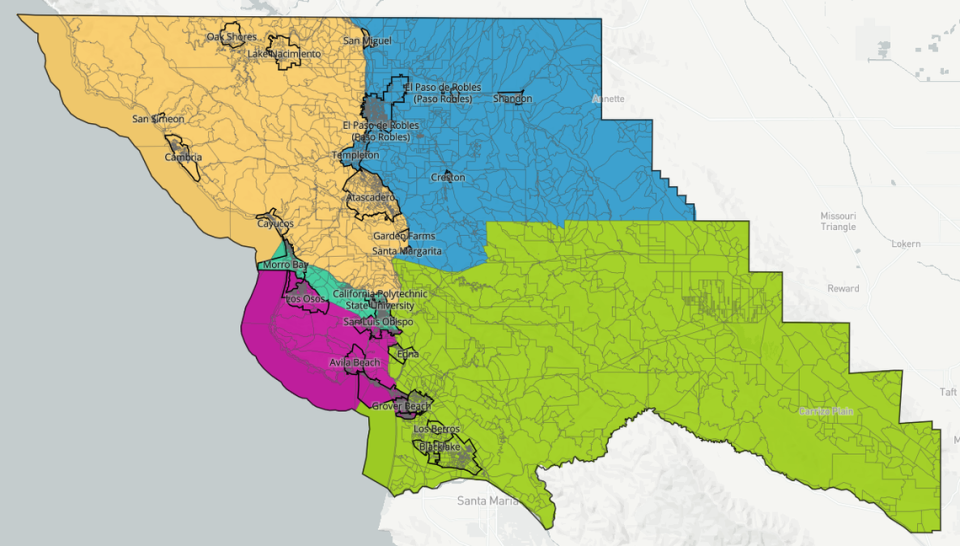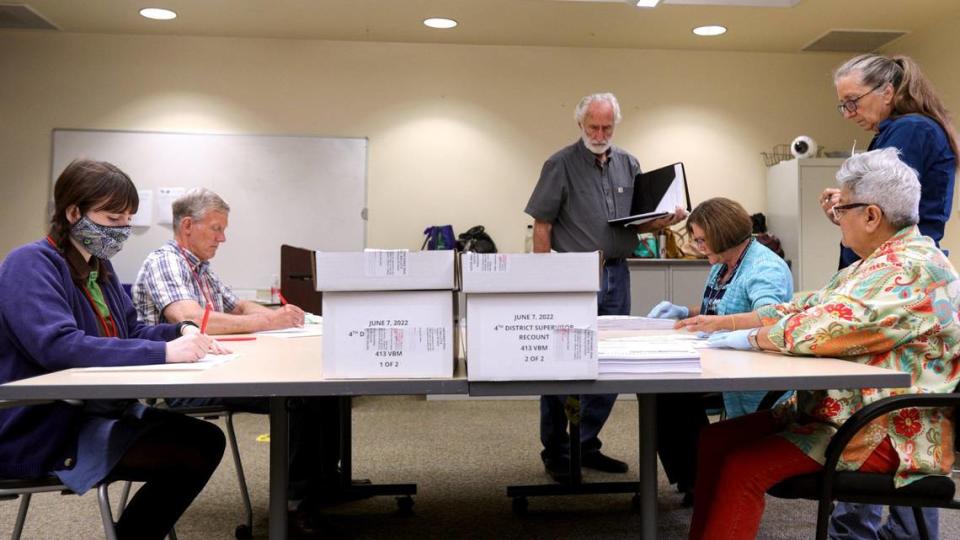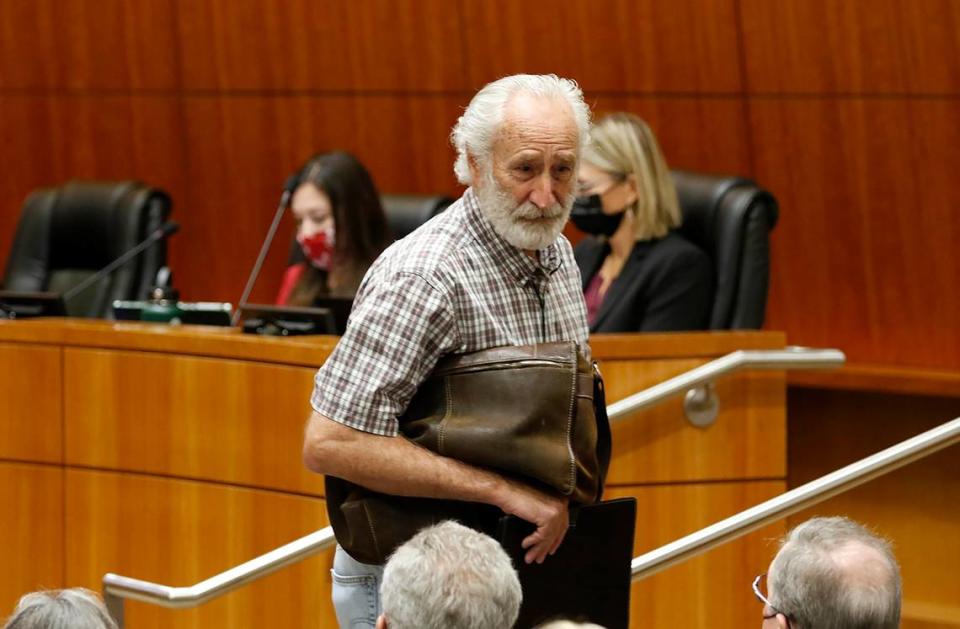SLO County supervisors toss out district map made by local man. He says board ignored voters
- Oops!Something went wrong.Please try again later.
A week after the San Luis Obispo County Board of Supervisors voted to effectively throw out the district map Richard Patten created, the Arroyo Grande resident shared his process for drawing the map — and his opinions on the current liberal board majority.
In 2021, Patten submitted a map to be considered during the county’s redistricting process — launching himself into local fame. He also participated in recent recounts of Board of Supervisors races.
That year, the board voted 3-2 to approve what became known as the Patten map.
Local group San Luis Obispo County Citizens for Good Government sued the county over redistricting in 2022, arguing that the Patten map split up communities of interest and advantaged Republican voters.
On March 21, the board voted to settle the lawsuit, agreeing to throw out the Patten map and pick a new one.
On Tuesday, supervisors planned to vote to set a hearing to pick a new map.

Does district map favor Republican candidates?
Three conservative supervisors — John Peschong, Debbie Arnold and Lynn Compton — voted to adopt the Patten map.
A Tribune analysis of the Patten map in 2021 showed that it packs Democrats into Districts 3 and 5 — making it easier for Republican candidates to win Districts 1, 2 and 4 and maintain a conservative majority on the board.
The reshuffling of the districts ended with a conservative-leaning map.
For example, the liberal-leaning town of Oceano moved from District 4 to District 5, leaving District 4 with more conservative voters.
Edna Valley and the San Luis Obispo Country Club area also moved into District 4, adding more registered Republicans to the area.
District 2, formerly a coastal district stretching from Los Osos to the top of the county, also changed.
Under the Patten map, liberal-leaning Morro Bay and Los Osos were parceled out to other districts, while Atascadero — a more conservative inland city — moved into District 2.

Patten didn’t draw the map to advantage any group, he said, even if it looks like it.
“No district was based on any political motivation,” Patten said.
Patten, who is the District 4 chair of the SLO County Republican Party, said that his opinions are his own and not representative of any organization.
Patten said he didn’t consult data on the political makeup of the county when he drew the map. In fact, he said he’s still not aware of the local distribution of Democrats and Republicans.
“I still don’t know the political distribution by district. I never looked it up,” Patten told The Tribune.
Supervisor Bruce Gibson, however, said he doesn’t believe that Patten is unaware of the county’s political makeup.
“I find that preposterous,” Gibson told The Tribune. “Its quite clear that that map was crafted understanding where Democrats and Republicans live.”
Patten said that California law prohibited him from considering the political makeup of the county while drawing the map, so he steered clear of political data.
Patten interpreted the law differently than the county did.
Though the California Election Code and Fair Maps Act bans the county from adopting a map specifically to advantage or disadvantage a political party, it doesn’t prevent the board or other parties from reviewing partisan data along with other data, according to county counsel Rita Neal.
“(Partisan data) is one of many factors to adopt a map, just like the communities of interest, just like geographic continuity,” Neal said.
Why did SLO County man create district map?
Patten, who previously worked in computer programming, created his district map as a sort of retirement project, he said.
“Sometimes retired people have too much time on their hands,” Patten said. “I read that any citizen can draw and submit a map, so I took the challenge.”
Patten said he had been politically active through voting and investigating election integrity related to mail-in ballots, but wanted to get more involved.
“I just needed something to do,” he said.
Patten had some prior experience with maps, he said.
When Patten worked as a computer programmer, he analyzed how many people in a given area might be interested in buying his client’s products, he said.
Patten drew the district map by himself, he said.
He denied accusations that he worked with the Republican Party of San Luis Obispo County on the map.
“I found in my personal career ... that the less outside comments you have, or the less outside work that you take in, the better,” Patten said, “because there are so many different opinions about how things should be.”
Besides, he said, “the Republican Party is too busy raising money and staying afloat.”
“What I did was use my best judgment,” Patten said.
Patten said he used two online map-building tools to design his map, but he refused to share the names of the tools.
“I don’t want anyone to scrutinize their business,” he said.

Arroyo Grande resident: Designing districts was ‘a math problem’
As part of the process, Patten said he consulted the California Election Code, which has numerous rules including establishing “substantially equal” populations in each district and keeping communities of interest intact.
A community of interest is “a population that shares common social or economic interests,” the code says. This doesn’t include political parties.
“I looked at past maps and then you read through the rules and decide what to do based on what the rules say,” Patten said. “I’m a rule follower.”
Patten said he did his best to design the districts so the populations were similar to each other.
“It’s just a math problem,” Patten said. “You have so many people in the county and divide it up by five districts and you do the math and that’s your basis.”
He used roads, property lines and fence lines to draw the district boundaries, and did his best to keep cities and communities of interest intact, he said.
San Luis Obispo was the only local city that Patten split into two districts because its population is so large, he said.
In Patten’s map, Cal Poly is located in one district — District 5. That was not the case in other potential district maps the board reviewed before choosing Patten’s, he said.

Liberal supervisors ignore citizens, Richard Patten says
Patten said he doesn’t have a preference over which map the board selects to replace his.
“Whatever they want to do is fine,” Patten said.
However, he expressed concerns that the board’s three liberal supervisors voted to discuss the lawsuit in closed session on Jan. 24.
Neal said that it’s legal for the board to discuss lawsuits in closed session so as not to reveal their tactics to the other party in the lawsuit.
Patten said that the current liberal majority won’t listen to voters who disagree with them.
“The map is secondary to my concern,” Patten said. “We live in a country where it’s supposed to be a government by the people, for the people, of the people, but the people in this county are not allowed.”
Patten said that the board listened to SLO County Citizens for Good Government because the group is liberal-leaning.
“It was a ruse,” Patten said of the lawsuit. “It’s set up by the Democratic Party to get (the map) off the table and get it redrawn.”
SLO County Citizens for Good Government representative Linda Seifert, however, said that the lawsuit was a grassroots effort to repeal the map.
She noted that citizens unhappy with the map showed up to vote in 2022 for supervisor candidates who were outspoken about disagreeing with the map.
Gibson won by 13 votes in a conservative-leaning District 2, and Supervisor Jimmy Paulding also won narrowly in a conservative-leaning District 4.
“Where process is utilized improperly, people are willing to come forward. I think a piece of Bruce’s victory in a district that was almost impossible for him to win was partly because of the redistricting issue,” Seifert said. “The way it was handled mattered to the people that came to vote. They don’t want their government run that way.”
Repealing the Patten map reflects the will of the voters, she said.
Patten didn’t see the lawsuit in the same light.
“The League of Women Voters and the Citizens for Good Government, do you think they would follow the orders of Bruce Gibson?” Patten asked, though he did not present any evidence that the groups had coordinated with the supervisor.
He said the lawsuit had “peculiarities” in “transparency,” but wouldn’t elaborate.
Gibson said he did not coordinate with SLO County Citizens for Good Government to create the lawsuit.
“That is a completely unsurprising filtering of the facts,” Gibson said. “Citizens for Good Government spontaneously rose up. They raised close to $400,000 in two months, people were that outraged at the adoption of that map.”

